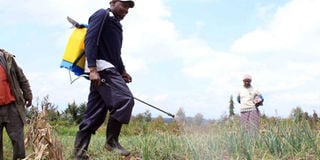Ideas and Opinions: Chemical residue rules a big barrier to food trade

John Mbaria sprays his onion plants with pesticide at Endarasha in Nyeri. Food and Agriculture Organisation estimates that pests are responsible for 40 to 60 per cent of food losses in East Africa, hence, pesticide use is critical in the production and export of crops from this region. FILE PHOTO | NATION MEDIA GROUP
What you need to know:
- Food and Agriculture Organisation estimates that pests are responsible for 40 to 60 per cent of food losses in East Africa.
- Codex standards are set to ensure that food is safe and can be traded. The 188 Codex members have negotiated science-based recommendations in all areas related to food safety and quality.
- Early this year, the 22nd Session of CCAFRICA, which is the FAO/WHO Coordinating Committee for Africa on Codex standards, was held in Nairobi, Kenya.
- And now, the Agrochemicals Association of Kenya, CropLife Kenya and CropLife Africa Middle East, have organised a two-day workshop in Nairobi to discuss pesticide risk assessment and trade impact for agricultural commodities.
Trade barriers for agricultural commodities have been discussed for a long time, yet one big puzzle called Maximum Residue Limit (MRL) remains unsolved.
If there is a notorious trade barrier to agricultural commodities, it is this measure. MRLs refer to the highest concentration of a pesticide residue that can be permitted in or on food crops and animal feeds.
The problem is that because there are no harmonised standards for MRLs, importing countries set own limits at whims. This has been used by some to deliberately block commodities from others.
Recently, concerns have intensified about the use of extremely low default levels for MRLs in food and feed commodities that are exported to markets in Europe and Asia.
Granted, MRLs between countries differ as the pressure of weeds, insects and crop diseases vary from one country to another, resulting in different pesticide use patterns and varying critical Good Agricultural Practices (GAPs) to achieve control.
In this sense, harmonising MRLs may be seen as a complex goal, but it is achievable and necessary. All that is required is committed participation of all stakeholders in the food value chain.
Food and Agriculture Organisation estimates that pests are responsible for 40 to 60 per cent of food losses in East Africa. Hence, pesticide use is critical in the production and export of crops from this region.
However, because there are no set MRLs, these commodities are subjected to default MRLs in the importing markets. Some retailers in those markets set much lower MRL values – far below the legal limit – in an attempt to meet the desires of specific consumer groups.
STRIKING THE BALANCE
Yet MRLs are not safety standards in themselves. Levels exceeding the MRLs can still be safe for consumers. Safety assurance would require a new risk assessment to be conducted by experts.
For example, the Codex Alimentarius, or “Food Code”, is a collection of standards, guidelines and codes of practice adopted by the Codex Alimentarius Commission – the central part of the Joint Food and Agriculture Organisation and World Health Organisation Food Standards Programme.
Codex standards are set to ensure that food is safe and can be traded. The 188 Codex members have negotiated science-based recommendations in all areas related to food safety and quality.
MRLs, on the other hand, are basically about good agricultural practices. If pesticides are used as recommended by the manufacturer, pest, weeds and diseases can be effectively controlled.
Commodities will contain trace amount of residues not exceeding the MRLs.
Thus, the desire to strike that balance between pesticide use and food safety standards remains the subject of many fora. Mid last year, Kenya hosted the 22nd Session of the Intergovernmental Group (IGG) on Tea’s, and the discussions were anchored on “The Effects of Maximum Residue Levels in Tea on International Tea Trade”.
Early this year, the 22nd Session of CCAFRICA, which is the FAO/WHO Coordinating Committee for Africa on Codex standards, was held in Nairobi, Kenya.
CRITICAL QUESTIONS
This meeting also discussed the MRL question in connection with international trade in food commodities.
And now, the Agrochemicals Association of Kenya, CropLife Kenya and CropLife Africa Middle East, have organised a two-day workshop in Nairobi to discuss pesticide risk assessment and trade impact for agricultural commodities.
The workshop, which will take place on March 28 and 29, provides a platform for stakeholders to discuss this aspect and by extension the challenges related to harmonisation of MRLs.
The workshop seeks to answer critical questions: one, is global MRL harmonisation possible? Two, what challenges do regions or countries face currently in the establishment of MRLs?
Lusenaka is the CEO of Agrochemicals Association of Kenya/CropLife Kenya while Simiyu is the Director Regulatory Affairs & Stakeholder Relations CropLife Africa Middle East.





